A Trip to Saunders County Nebraska
Before making a trip to missionfriend historical sites in Saunders County, Nebraska, this Memorial Day, I refreshed my mind with the 1800's atlases of the area and the booklet my friend Lyle Person sent me last fall concerning the Estina Baptist story. I also did an internet search on Estina's famous son, Fredrik Franson, and was astounded to turn up fifteen pages plus of websites containing his name. The most fruitful was the site which listed the complete collection of his writings assembled by his biographer Torjeson and held by the Billy Graham Institute Archives. It is also of note that Franson's world travels yielded evidence of interest globally; there were websites from many countries and in several languages citing his name.
The township maps show not only Estina, but the land belonging to Lutheran Pastor S. G. Larson and the Hallners. Since last fall my interest in Andrew Hallner had grown even keener with the acquisition of his short autobiography from the Covenant Archives. Though it was to prove challenging, I was determined to visit Swedeburg Lutheran church which a friend had sought in vain a few years ago looking for burial sites of her ancestors. Since it was Memorial Day weekend, our poking about the cemeteries would be less conspicuous.
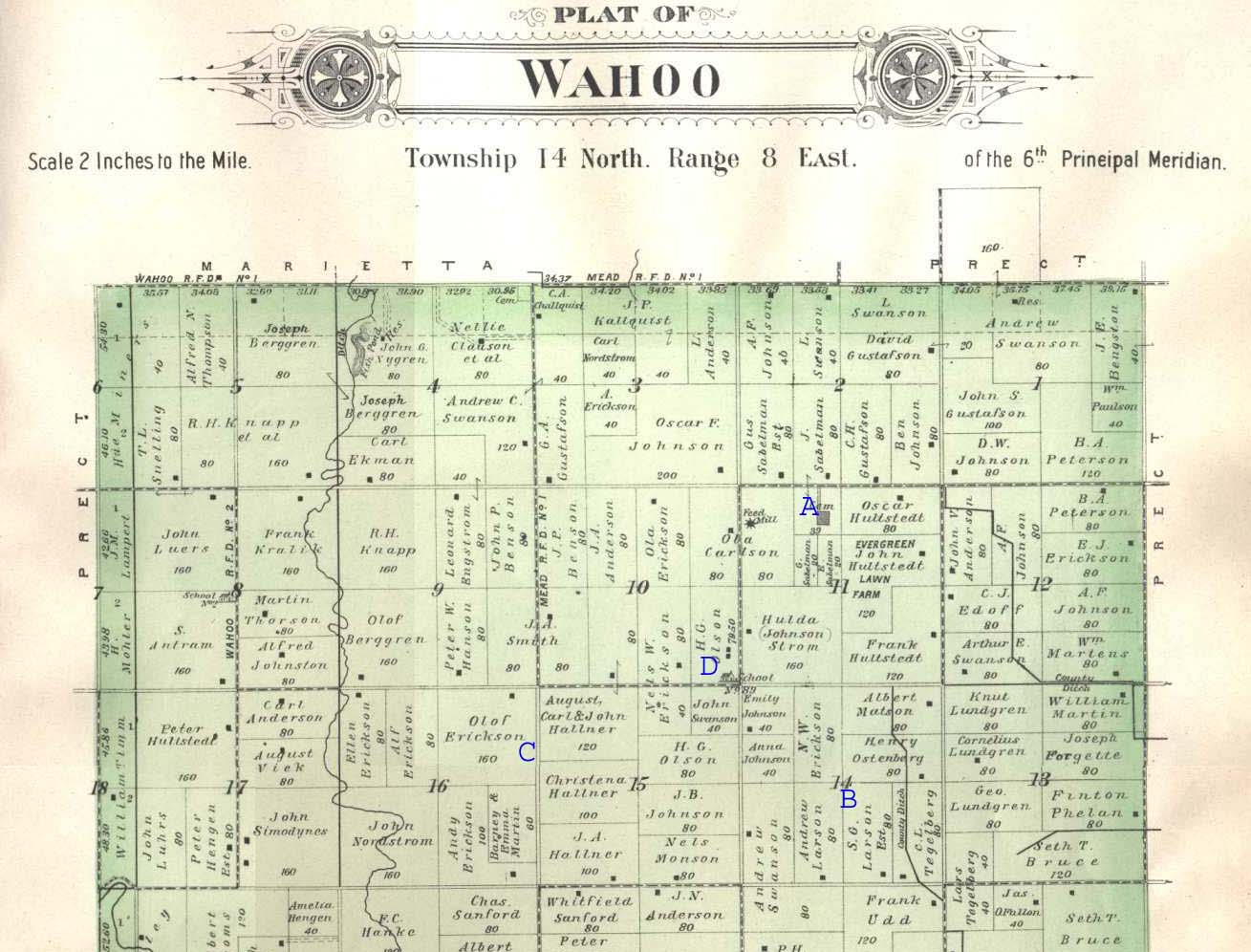
From the 1880's maps on Genweb website
A. The original Alma cemetary site, now a few miles west
B. The S.G. Larson homestead
C. The Hallner homestead
D. The sod "Hallner Schoolhouse"?
The day did not disappoint. Lyle and Dianne were on duty at the Mead church for morning worship and even graciously invited us to dinner. At the fellowship hour at the church we were delighted to meet Roger Nelson, who was the very person who now farmed the land on which Estina Church stood and could provide us with directions to it and the other cemeteries on our list. We were off to a great start.

The Alma Lutheran Church of Mead, Nebraska
The stately 1886 Alma church represents one of the three oldest Augustana Lutheran congregations in Nebraska, and its first Pastor, S.G. Larson, the pioneering missionary and church founder in the state. We are indebted to C.F. Sandahl for the story of Larson which forms the first figure of our "three Swedish churchmen." His farmplace is indicated on the township atlas and lies just beyond the one visible in the scene below, but was erased from private ownership by the building of the Mead Ordinance Plant by the U.S. government in world war two. It is now part of the extensive University of Nebraska school of agriculture. (Across the road from his place was the home of the Udd family, who were displaced at the same time to my hometown of Wausa, to Mead's loss and Wausa's gain.)

Hallner's farm with S.G. Larson's beyond
Near these same fields stood the site of the first modest building of the Alma congregation, built in 1874. Later a block on the south edge of Mead was donated and the church seen above built there. The 1874 church and cemetery site are recorded on the atlas we used and caused some confusion in locating the cemetery. Cemeteries are usually permanent, but Alma's proved to be a couple of miles west of where we (and Sandahl) assumed. Sandahl tells us that the early church was not usable in cold weather and that services were held in homes and in a sod schoolhouse that stood at the diagnally opposite corner of the section shown here. This was called the "Hallner schoolhouse" and charter member Andrew Hallner's family owned the west half of the section, the land shown in the immediate foreground. There will be much more to this story, as he is the next of the "three Swedish churchmen." As we took this picture, a farmer stopped to see if we were experiencing car trouble. When we explained our purpose, he volunteered his own family story in friendly midwestern fashion
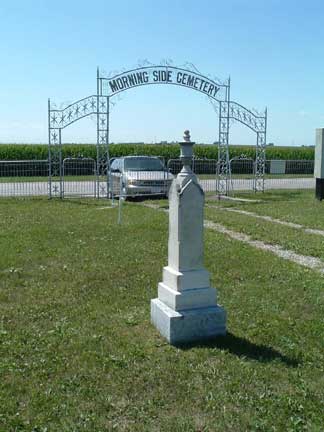
Pioneer Mead Pastor P. Dillner's gravesite
(On a subsequent visit to Mead we recorded the following: "On the way to Wahoo we passed through Mead and wanted to take a picture of a gravestone we saw earlier at the cemetery there of Rev. Peter Dillner. This we did and later determined that he died there while serving the Covenant Church. Looking around we also noted the grave of Rev. Arvid Adell and early Mead Covenanters Chris Gustafson and Senator C.H. Gustafson whose descendants we count as friends. We were startled to see also the graves of Wausa residents Waldemar and Francis Udd, the Udds being from the Mead area and among those displaced by the ordinance plant during world war two. Waldemar was both my Sunday School teacher and employer as president of the Stromsburg Covenant Home board of directors. We would have assumed them to be buried at Wausa.")
We have found another Wausa connection in the centennial book...the Anderson family: Carl August Anderson, then of Geneseo, Illinois, "had subscribed to a...Swedish weekly, 'Gamla och Nya Hemlandet'. Rev. S.G. Larson, who was establishing three Lutheran colonies in Saunders County wrote several articles inviting Swedish immigrants to settle there. Eighty acres were available for the filing fee of just $14...Their farm was nothing but prairie. August built a one-room shanty, 12' by 18'. It was several years before any rooms could be added. The fire for heating and cooking was fed with slough grass and buffalo chips. Prairie fires were a threat every fall, but Carl remembers the great fire of 1873. Carl was just over three years of age. Their home was just in the path of the fire. A number of settlers from miles around with teams and plows had gathered to lay up fire guards and fight the progress of the fire, but the wind was strong and the fire jumped every guard and swept along despite all efforts to check it. Their home was right in the path of the fire. Mother, brother Albert and the baby Theodore and Carl were put in the house. Mother was just beginning to flee when one of the men, Bengt Johnson, came rushing in. He shouted that the house was doomed and we must run for our lives. Saying so, he grabbed Carl by the arm and started to run. He ran right through the fire. There was nothing for mother to do, but follow Bengt Johnson on his wild run and this she did, carrying baby Theodore in her arm and leading brother Albert by the other hand. There they all sat in smoke and soot while the fire swept on its way. Towards evening mother took the boys and started back up the hill to view what they thought would be the ruins of their home. But by a miracle the house and the old straw barn had been saved."
By referring to the map above, the location of this remarkable story can be found in section 10. J.A. Anderson is Johan Albert to whom the land was deeded when the other members of the family moved to Wausa. The Johnson place is across the road. Brothers Frank and later Carl became editors of the Wausa Gazette for fifty years. Albert's son Gilbert married Marjorie Johnson Anderson, who as teacher of our country school district #32 has shared with me pictures of my father as a student there. Sandahl reports in 1931 that a Theodore Anderson from Wausa is superintendent of the Swedish Sanatorium in Denver. If this is the same Anderson, it would be the same institution uncle Hugo Rodine served as chaplain from 1960-66. We have subsequently been in touch with Theodore's son.
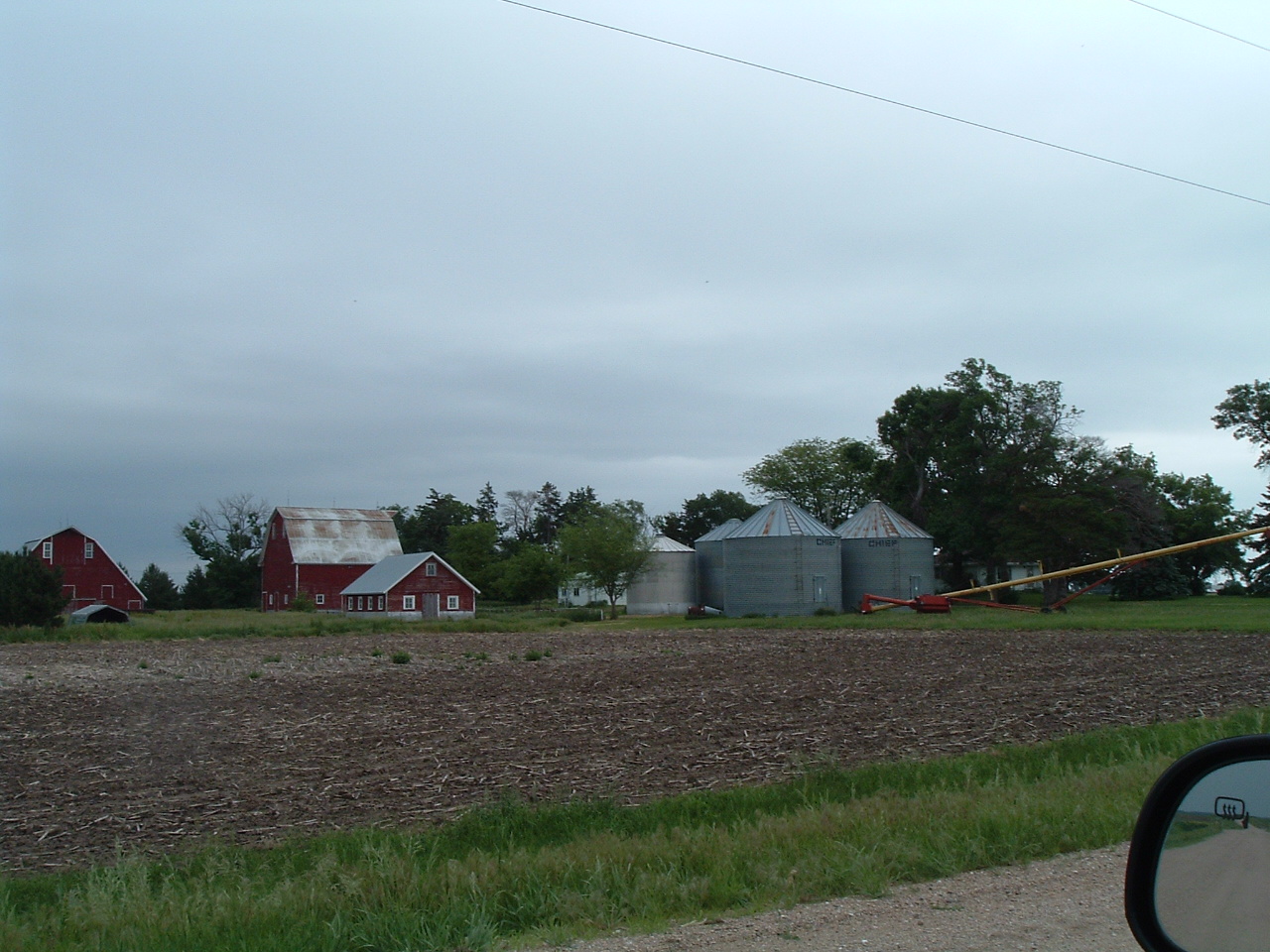
The present farm place on the Hallner homestead
Another Anderson story: "The blizzard of 1-12-1888 was another memorable event. Carl was about nine years old at the time. When the family got up that morning it was snowing quite heavily, but not very cold. However, Carl's parents concluded that sister Cecelia and Carl had better not go to school that day, but brothers Frank and Theodore, having had their dinner pails made ready, went as usual. All day the snow kept falling down in large flakes. There being no wind the snow piled high on every branch and twig and on top of the fence posts. Ever deeper and deeper the snow kept piling up. This continued till about three o'clock in the afternoon, when all at once the wind swung to the northeast and came with the velocity of 40 to 50 miles per hour; the blizzard was on. Father and brother Albert went to the barn and harnessed up a team and hitched them to the sled planning to drive to the school, a mile and a half away and bring Frank and Theodore home. The farmyard was well sheltered by a large grove on the north and west. When Father and Albert reached the edge of the grove they realized that to face the storm for a mile and a half would mean only death to them and the horses. It was a sleepless night and the parents could only wait and pray that the children were safe at the school. The following morning the storm had abated and the team was again harnessed and they started for the school. Imagine the joy in every home who had children in the school to find that everyone was alive and safe. The teacher and some of the children had been come for by the farmer with whom the teacher boarded and the older boys had spent the night in the school house." Referring to the map above, we can see that the school in question was most probably the "Hallner schoolhouse."
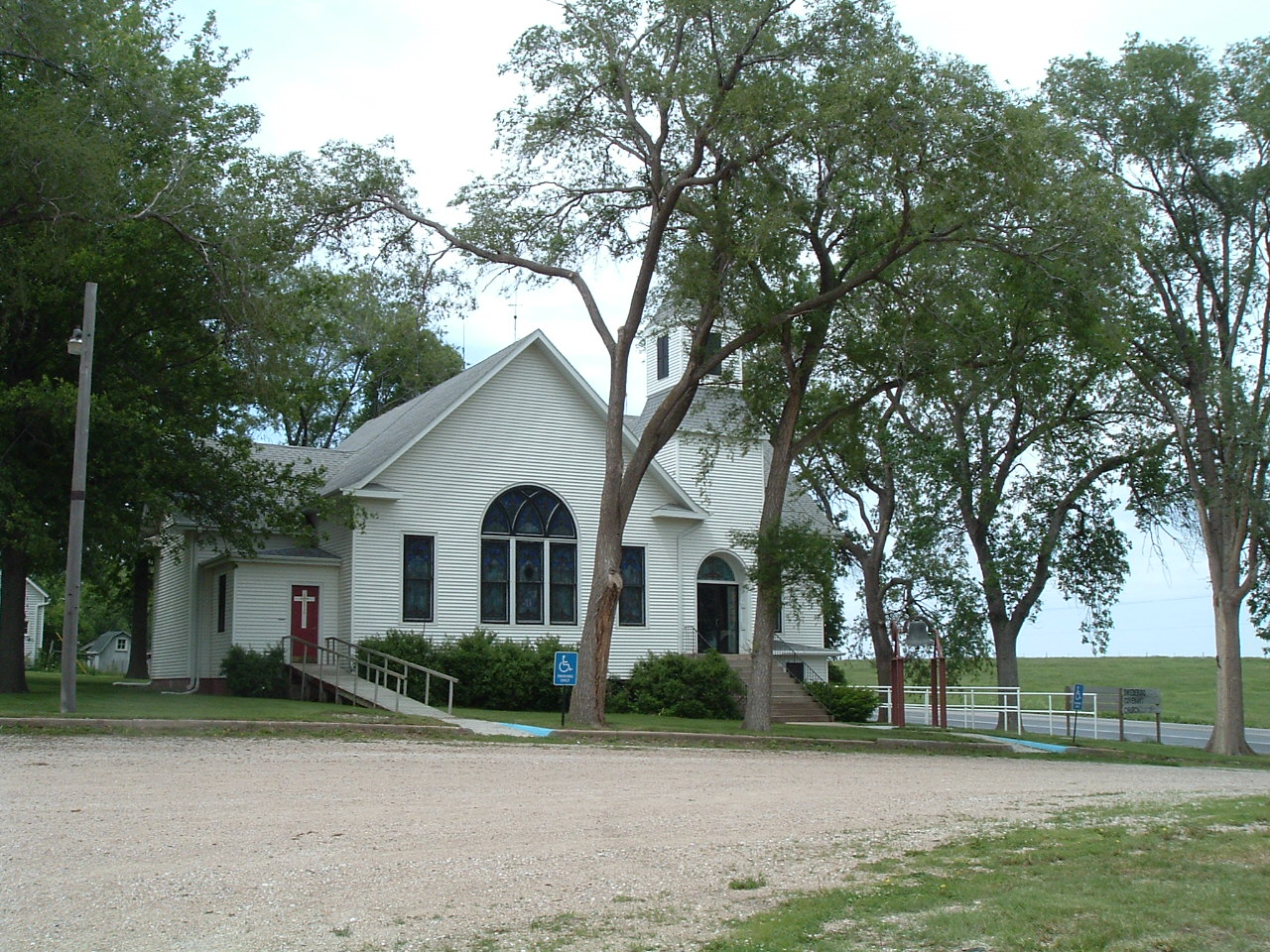
Swedeburg Covenant Church
The Swedeburg Covenant Church is the one most associated with Andrew Hallner since he was its first Pastor. Our friend, Robert Kronberg, retired from ministry here as was very fitting, since he was Hallner's grandson. This 1909 building alongside the present highway was the third church. The congregation had already outgrown one earlier building west of "Swedeburg Station" and lost another to fire caused by lightning. Swedeburg is just a few miles west of Mead and is the site of the earliest influx of Swedish immigrants in the area. A group led by S.G. Larson settled here in 1869 just west of the present townsite. These pioneers were eager to begin churches and the Swedeburg group organized in 1870, but it should be noted that their missionary Pastor was based in Omaha at the time, and could visit Mead only once a month and Swedeburg even less often.
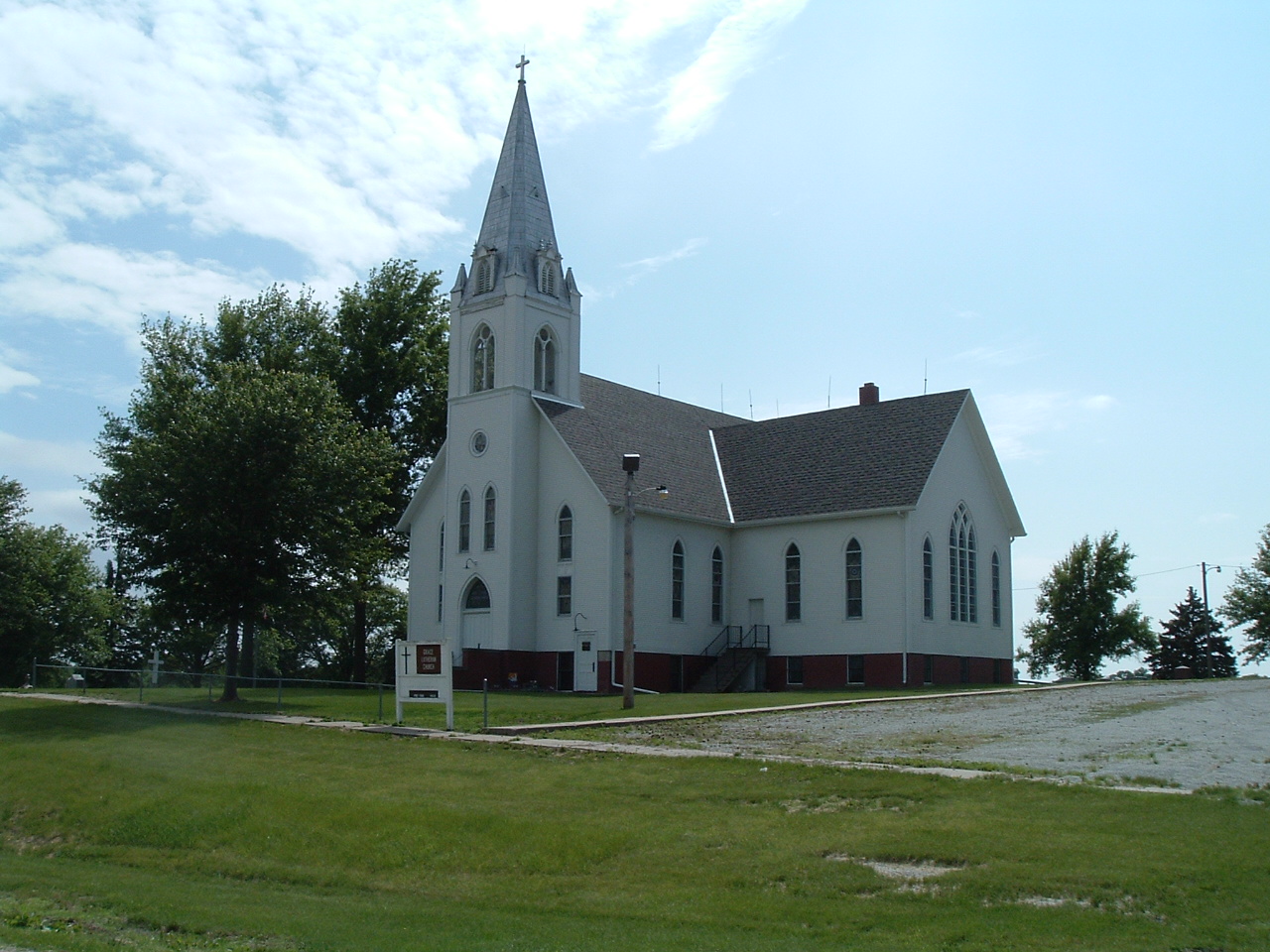
Swedeburg Lutheran Church
With the help of a Swedeburg resident we were able to locate the elusive (to us) Swedeburg Lutheran Church and cemetary. Hallner preached at this church and was encouraged by S.G. Larson to pursue ministerial studies at Hasselquist's Augustana seminary in Paxton, Illinois, but other events ensued as we shall see. The beautiful 1916 church building seen here was the third building on this site, evidence of the success of the Swedeburg Lutherans. A new divided highway now runs diagnally between Swedeburg and the Lutheran site which complicates the old familiar orientation of the area.

The surviving Estina Swedish Baptist Church...at Hjältmans' Pond
The last of the "three" is Fredrik Franson, representing both the Swedish Baptists and the Swedish Free Mission denominations, but particularly the Scandinavian Alliance Mission of which he was the founder. Along this creek, believed to be the site of Hjältman's pond, seventeen-year-old Franson was baptised into the Estina Swedish Baptist congregation. The church on "Prayer Hill" (bönekullan) has incredibly survived...in the form seen in this picture, relocated a mile or so north and converted to a farm shop in 1920. The congregation was formed in 1870 and the church completed in 1879. Along with the Estina cemetery to the east, the site lies four miles northeast of Mead.

Estina Church as it appears in 1919